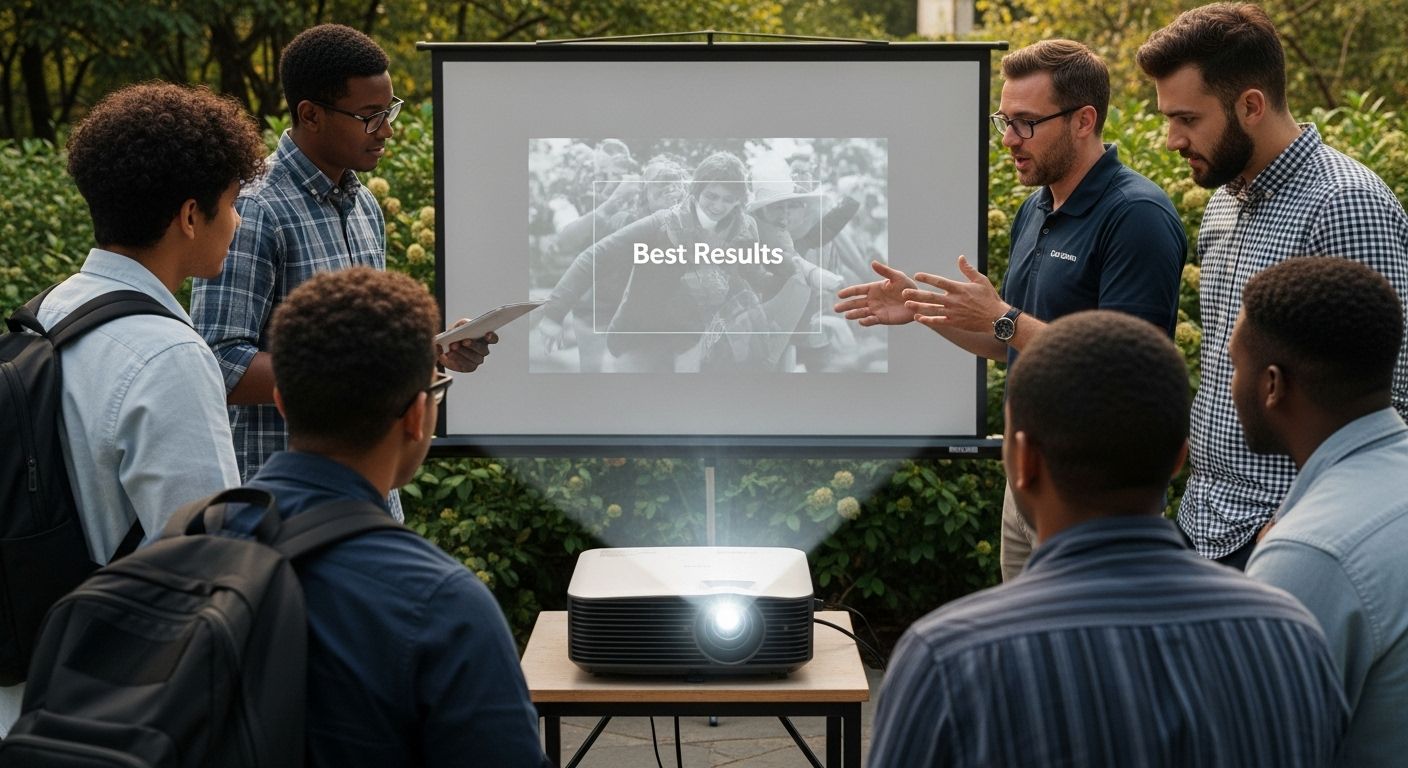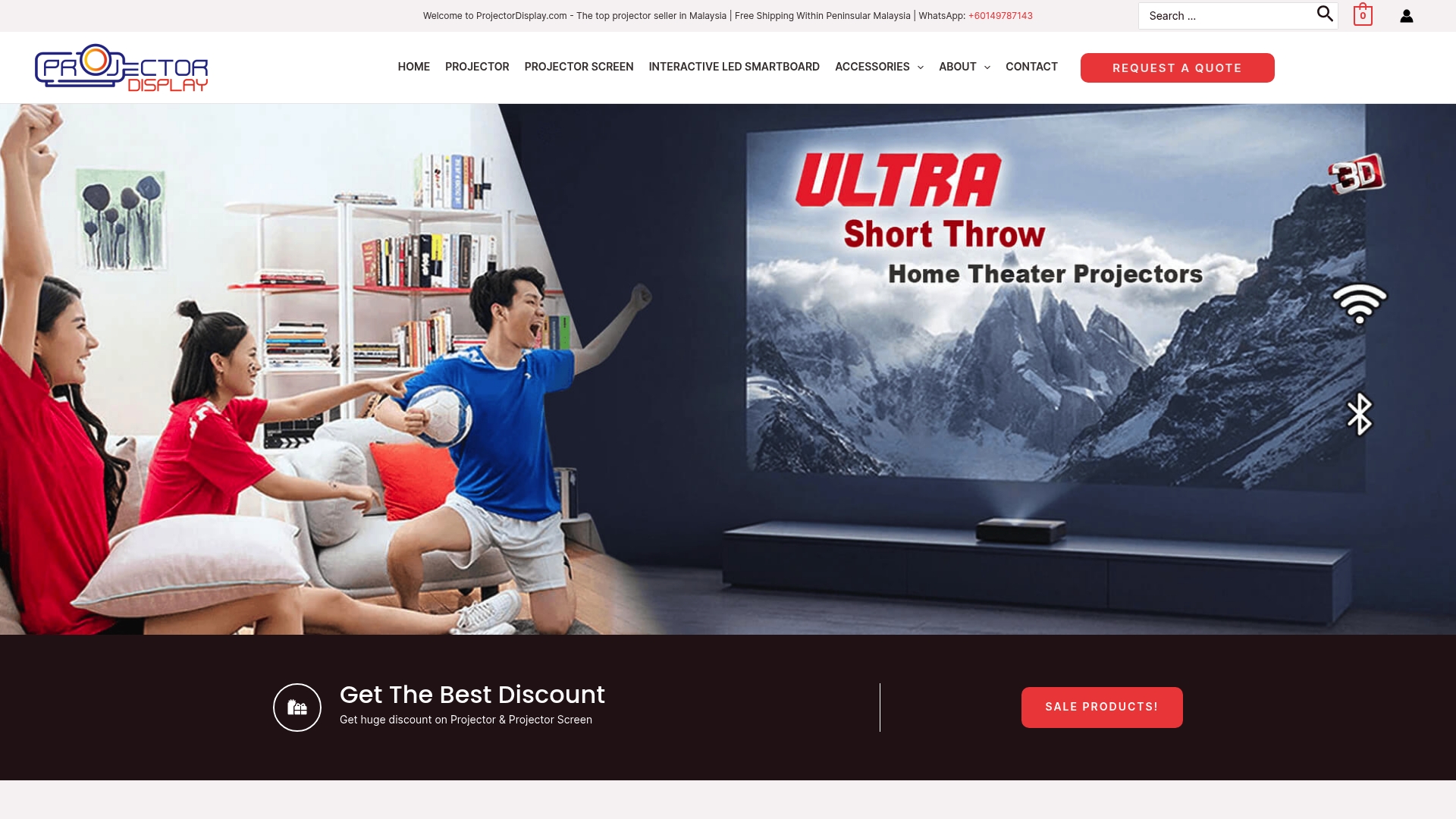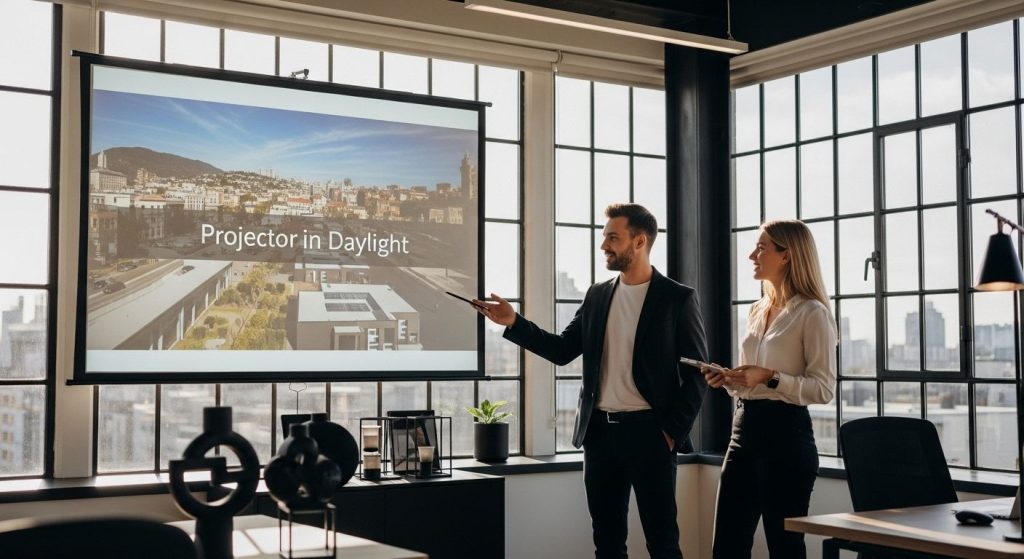Projectors can turn any wall into a massive screen, making movies or presentations feel larger than life. But did you know that some projectors need at least 6000 lumens just to make images visible in daylight? Most people assume a crisp picture is all about fancy screens and high-definition sources, but the real secret has a lot more to do with how projectors battle ambient light than you might think.
Table of Contents
- What Are Projectors And How Do They Work?
- Why Daylight Affects Projector Performance
- Key Features For Projectors In Bright Environments
- Real-World Applications Of Projecting In Daylight
- Tips For Maximizing Projector Use In Daylight Settings
Quick Summary
| Takeaway | Explanation |
|---|---|
| Projector brightness matters significantly | Higher lumen ratings enhance visibility in daylight, with at least 3000 lumens recommended for good performance. |
| Choose the right projection surface | Select screens like matte white or ALR to improve contrast and reduce light interference in bright conditions. |
| Employ advanced optical technologies | Features like dynamic iris technology and high contrast ratios help maintain image quality under varying light conditions. |
| Manage environmental lighting effectively | Controlling ambient light and positioning can dramatically improve projected image clarity in professional settings. |
| Understand projection technology types | Familiarize yourself with LCD, DLP, and laser projectors to select the best fit for specific uses and environments. |
What Are Projectors and How Do They Work?
Projectors are sophisticated optical devices that transform digital or analog visual content into enlarged images projected onto external surfaces like walls, screens, or other flat areas. At their core, these remarkable devices leverage advanced light manipulation technologies to create vibrant, expansive visual displays across various settings.
Fundamental Optical Principles
The primary mechanism behind projectors involves complex optical engineering. Light passes through or reflects off an image source (such as LCD panels or digital chips), which is then magnified and focused through precision lenses. Our comprehensive projector purchase guide provides deeper insights into these technical nuances.
Key components of a typical projector include:
- Light Source: Usually a high-intensity lamp, LED, or laser that generates bright illumination
- Image Generator: LCD, DLP, or LCoS chips that create the actual visual image
- Lens System: Sophisticated optical elements that focus and enlarge the image
Types of Projection Technologies
Modern projectors employ several distinct technologies, each with unique characteristics:
- LCD (Liquid Crystal Display) Projectors: Use liquid crystal panels to generate images, offering excellent color reproduction
- DLP (Digital Light Processing) Projectors: Utilize microscopic mirrors to reflect light, providing sharp image quality
- Laser Projectors: Emerging technology offering superior brightness and longer lifespan compared to traditional lamp-based systems
According to Britannica's technology section, these devices fundamentally work by producing images from digital sources and magnifying them through precise optical mechanisms. The image quality depends significantly on factors like brightness, resolution, and ambient light conditions, making projector selection crucial for optimal visual performance.
Below is a table summarizing the main types of projector technologies, highlighting their core mechanisms, advantages, and common use cases for easy comparison.
| Projection Technology | Core Mechanism | Key Advantages | Typical Use Cases |
|---|---|---|---|
| LCD (Liquid Crystal Display) | Uses liquid crystal panels to generate images | Excellent color reproduction | Classrooms, Business Meeting Rooms |
| DLP (Digital Light Processing) | Utilizes microscopic mirrors to reflect light | Sharp image quality, reliability | Home Theaters, Portable Use |
| Laser Projectors | Employs powerful lasers as the light source | High brightness, longer lifespan | Large Venues, Daylight Environments |
Why Daylight Affects Projector Performance
Projector performance in daylight environments represents a complex optical challenge where ambient light significantly impacts image quality and visibility. Understanding how natural light interacts with projected images becomes crucial for achieving optimal visual displays in bright settings.
Light Intensity and Contrast Dynamics
Daylight introduces substantial luminance that directly competes with a projector's light output. Ambient light overwhelms projected images by reducing contrast ratios and diminishing perceived image sharpness. Learn more about projector lumens in our comprehensive guide to understand how brightness measurements impact performance.
Key factors affecting projector performance in daylight include:
- Ambient Light Levels: Higher external light reduces image clarity
- Projector Brightness (Lumens): Higher lumen ratings combat ambient light
- Screen Surface Reflection: Matte or specialized surfaces minimize light scattering
Scientific Principles of Light Interference
Projected images rely on precise light manipulation, which becomes challenging when competing with natural illumination. According to scientific research on visual display technologies, daylight introduces multiple interference mechanisms that degrade image quality:
- Luminance Competition: Sunlight overwhelms projector light sources
- Contrast Reduction: Bright environments wash out projected image details
- Color Distortion: Natural light alters color perception and accuracy
Professional projector users must strategically manage environmental lighting conditions to maintain visual performance. Selecting high-brightness projectors, using specialized screens, and controlling ambient light become essential strategies for achieving superior image quality in daylight settings.
This table compares different projection screen surface options for daylight use, clarifying their characteristics and unique benefits to help you choose the right solution for bright environments.
| Screen Type | Key Characteristics | Daylight Advantages |
|---|---|---|
| Matte White | Superior light diffusion, neutral color | Even image, minimizes glare |
| Gray Projection Surface | Enhanced contrast, absorbs more ambient light | Better black levels, improved contrast |
| ALR (Ambient Light Rejection) | Engineered to reject external light sources | Maintains clarity, combats bright conditions |
Key Features for Projectors in Bright Environments
Projectors designed for bright environments require specialized features that enable superior performance under challenging light conditions. Understanding these critical characteristics helps users select equipment capable of maintaining visual clarity and image quality in daylight settings.
High Brightness and Lumen Specifications
Lumens represent the most critical metric for daylight projection performance. Higher lumen ratings directly correlate with a projector's ability to combat ambient light interference. Check out our comprehensive guide on projector lumens to understand precise measurement standards.
Key brightness considerations include:
- Minimum Recommended Lumens: 3000 lumens for moderate daylight environments
- Optimal Lumens: 4500 6000 lumens for extremely bright spaces
- Professional Grade: 6000+ lumens for large venues with significant ambient light
Advanced Optical Technologies
Modern projectors incorporate sophisticated optical technologies specifically engineered to enhance performance in challenging light conditions. These innovations go beyond traditional projection methods:
- High Contrast Ratio: Enables clearer image definition against bright backgrounds
- Advanced Color Processing: Maintains color accuracy under intense ambient lighting
- Dynamic Iris Technology: Automatically adjusts light output to compensate for environmental changes
According to projection technology experts, selecting a projector with robust optical design becomes crucial for maintaining image quality in diverse lighting environments. Professional users must consider not just raw brightness, but also sophisticated light management technologies that preserve visual fidelity across varying illumination conditions.
Real-World Applications of Projecting in Daylight
Projecting visual content in daylight environments requires strategic approaches across multiple professional and creative domains. Understanding how to effectively utilize projectors under challenging lighting conditions opens up innovative possibilities for communication, education, and artistic expression.
Professional and Educational Settings
Daytime projection technologies have transformed workplace and learning environments. Conference rooms, classrooms, and collaborative spaces now leverage high-performance projectors capable of delivering clear visual information even with significant ambient light. Explore our comprehensive guide on projection mapping to understand advanced visualization techniques.
Key professional application areas include:
- Business Presentations: Maintaining visual clarity during daytime meetings
- Educational Demonstrations: Enabling interactive learning experiences
- Training Environments: Supporting comprehensive visual instruction
Creative and Artistic Implementations
Artists and designers have discovered remarkable opportunities for projection in bright environments, pushing technological boundaries of visual representation. Innovative approaches leverage specialized equipment to create immersive experiences that transcend traditional lighting limitations.
Creative projection domains encompass:
- Public Art Installations: Large-scale visual displays in outdoor settings
- Architectural Projection Mapping: Transforming building facades
- Interactive Exhibition Design: Engaging visitor experiences with dynamic visuals
According to advanced projection research, emerging technologies are developing sophisticated methods for calibrating projectors to replicate and manipulate environmental lighting. These innovations promise to further expand the potential of projection technologies across professional, educational, and artistic domains, making daylight no longer a significant barrier to high-quality visual communication.
Tips for Maximizing Projector Use in Daylight Settings
Successfully utilizing projectors in bright environments demands strategic planning and technical understanding. Professionals and enthusiasts must implement targeted techniques to overcome ambient light challenges and maintain superior visual performance.
Strategic Screen and Placement Techniques
Projection surface selection represents a critical factor in daylight performance. Specialized screens designed to enhance contrast and minimize light reflection become essential for maintaining image clarity.
 Explore our comprehensive projector screen placement guide to understand optimal positioning strategies.
Explore our comprehensive projector screen placement guide to understand optimal positioning strategies.
Key screen and placement considerations include:
- Matte White Screens: Provide superior light diffusion and reflection control
- Gray Projection Surfaces: Enhance contrast in bright environments
- Ambient Light Rejection (ALR) Screens: Specifically engineered to minimize external light interference
Advanced Equipment and Configuration Strategies
Professional users can leverage sophisticated equipment configurations to mitigate daylight projection challenges. High-performance projectors with advanced optical technologies enable remarkable visual clarity under challenging lighting conditions.
Critical configuration approaches encompass:
- High Brightness Projectors: Minimum 4000 lumens for effective daylight performance
- Precise Angle Positioning: Minimize direct light exposure on projection surface
- Dynamic Contrast Enhancement: Utilize built-in technologies that adapt to environmental lighting
According to educational technology research, understanding permissible viewing times and luminance levels becomes crucial for maintaining visual comfort and projection effectiveness. By implementing these strategic approaches, users can transform challenging daylight environments into optimal projection spaces.

Turn Daylight Projection Challenges into Stunning Visual Success
Struggling with washed-out images during daytime presentations? You are not alone. This article highlighted just how much daylight can impact brightness, contrast, and color accuracy when using a projector. When ambient light overpowers your display, even high-quality visuals can appear faded and uninspiring. Your audience might miss key details, and your efforts can go unnoticed if your projector and screen setup are not designed for bright environments.
Explore upgraded projector screens for daylight use that actively combat glare and boost image clarity even in challenging spaces.

Now is the time to transform your viewing experience. Browse the wide range of high-lumen projectors, professional screens, and innovative accessories at ProjectorDisplay.com. Discover the best solutions for office, classroom, or creative projects under Malaysia's bright conditions. Shop now to ensure your next presentation stands out anytime and anywhere.
Frequently Asked Questions
What should I look for in a projector for daylight use?
When selecting a projector for daylight use, prioritize high brightness (measured in lumens), a high contrast ratio, and advanced color processing technologies to maintain image clarity in bright environments.
How many lumens do I need for a bright room?
For moderate daylight conditions, a projector with at least 3000 lumens is recommended. For extremely bright spaces, aim for projectors with 4500 to 6000 lumens, or even higher for large venues with significant ambient light.
Can ambient light affect the image quality of a projected image?
Yes, ambient light can overwhelm a projector's light output, reducing contrast ratios and diminishing image sharpness. Managing ambient light is crucial for optimal visual performance.
What are the best screen surfaces for projecting in daylight?
Matte white screens, gray projection surfaces, and Ambient Light Rejection (ALR) screens are ideal for projecting in daylight as they enhance contrast and minimize external light interference.

